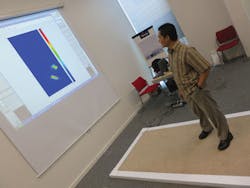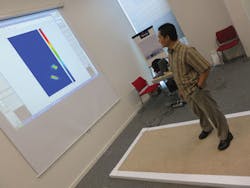'Smart carpet' promising for detecting falls
A carpet with an underlay of plastic optical fibers (POFs) can highlight subtle changes in gait that signal improvement or decline, and also detect when a person has fallen so help can be alerted immediately. Normally, patient observation and stopwatch exercises (for example, timing patients as they walk a few paces; normal walking speed should be at least 1 meter per second) are performed to detect abnormal gait, but they can take time to make an accurate diagnosis. The carpet promises to signal mobility problems before they would ordinarily be noticed.
The invention is the work of scientists at the University of Manchester in England and colleagues. Their prototype, which they're calling the SensorMat, is a 3 × 6 ft commercial carpet with a special underlay containing the POFs with tiny sensors at their ends to sense movement. The POFs bend when walked on, and their resulting signals are sent to a computer running data analysis software (National Instruments' LabVIEW), which map the signals' data as 2D images. Then, the mapped images can be analyzed to identify a sudden incident such as a fall or trip, or gradual changes in walking behavior. The latter could possibly predict a dramatic episode such as a fall.
The researchers, led by Dr. Patricia Scully from the University of Manchester's Photon Science Institute, say their carpet could be retrofitted at low cost to allow living space to adapt as the occupiers' needs evolve—particularly relevant with an aging population and for those with long-term disabilities. It could also be incorporated non-intrusively into any living space or furniture surface such as a mattress or wall that a patient interacts with, she adds.
The research team is currently evaluating a patent strategy, with the objective of commercialization. For more information on how their technology works, please visit www.youtube.com/watch?v=Egi03qNUzXo.

